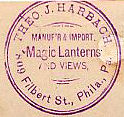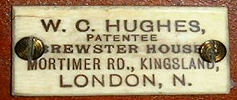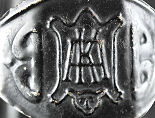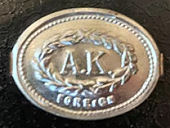 MANUFACTURERS, IMPORTERS, AND RETAILERS. H-K |
||
|
References: To produce this extensive list the following sources were consulted: Encyclopaedia of the Magic Lantern. The Magic Lantern Society, London, England, 2001. Van Toverlantaarn tot Kinematograaf. Vera Tietjens-Schuurman. Stichting Peter Bonnet Museum, Rottevalle, Friesland, the Netherlands, 1979. Laterna Magica, Zauberwelt und Faszination des optischen Spielzeugs. Ernst Hrabalek. Keysers Sammlerbibliothek G.m.b.H., Regensburg, Germany, 1985. and others. |
||
 |
HAGEDORN, WILLY Hagedorn was the founder of a theatrical lighting business in Berlin that started manufacturing dissolving view apparatus and lantern slides in the 1870s. They produced a full range of sciopticons and universal lanterns and were also one of the few German firms to produce a triunial lantern, the agioscope. |
|
HAHN-GOERTZ See GOERTZ, C.P. |
||
HALL, THOMAS American importer and manufacturer of dissolving view lanterns and sciopticons, including a dissolving equipment with the side-by-side lanterns combined in one unit. Boston, Massachusetts. (c. 1860s) |
||
HAMMER DRY PLATE Co. One of the most important American producers of 3.25 x 4 inch photographic glass lantern slides. (c. 1880s) |
||
 |
HARBACH, THEO J. American importer and manufacturer of magic lanterns and views. Together with Alfred Vick owner of the American Cyclepede Co. with a factory in Mt. Carmel, Ct and Office & Warerooms at 809 Filbert Street, Phila, PA., and the Magical Oraganette that he carried on alone. |
|
 |
HARRISON, W.B. British retailer of magic lanterns, active in Bridgestreet, Sunderland. |
|
HAUFSTAENGEL, FRANZ Kunstverlag Franz Haufstaengel, München, German firm of art publishers and manufacturer of lantern slides. |
||
HAWKRIDGE, S. American lantern manufacturer in Hoboken, New Jersey, and a successor to George Wale & Co. He produced a wide range of philosophical instruments, including the large Science or College lantern. (C. 1870s-1880s) |
||
HEATH & WING English instrument makers. Thomas Heath and Tycho Wing produced 'Magick Lanthorns, Pictures to ditto'. (1750s-1770s) |
||
HELMHACK, ABRAHAM German faïence painter who painted 'glasses for the so-called optical picture lanterns'. (c.1700) |
||
HENDERSON, ALEXANDER LAMONT British photographer and lantern slide maker. He supplied photographs to many firms, including G.W. Wilson, for commercial slide use. Some slides were double-width panoramas. (c.1850s-1900) |
||
 |
HENDERSON & AMES Co American manufacturer and retailer of magic lanterns, working in Kalamazoo, Michigan, USA. The company offered projectors, ceremonial swords, costumes and other regalia to such secret fraternal organizations as the Odd Fellows, Knights of Templar etc. Non specific to magic lanterns, Henderson's company was founded by Frank Henderson in 1850 and dissolved in 1923. The connection with Ames began in 1873. Around 1952 Henderson was eventually purchased in turn by M. C. Lilley & Company of Ohio and became known as the Lilley-Ames Company. |
|
HENRY HUSBANDS (& SONS) See HUSBANDS & CLARKE. |
||
HERBERT, SIDNEY American manufacturer of a wooden-bodied double magic lantern. (c. 1890s) |
||
HILL, NATHANIEL British mathematical instrument maker active in London who probably sold magic lanterns. (1746-1764) |
||
HILL, W.R. British slide painter; apprentice of H.L.Childe. Hill became his partner for 20 years until he set up his own business in 1867. He painted for the Royal Polytechnic Institution. His work includes famous scenes as the 3-foot wide panorama from 'Gabriel Grub' and the complex 'Angels on the Fields of Bethlehem', in which seven angels descended with independently-moving wings and the walking white rabbit in 'Alice in Wonderland'. Hill is also often credited as the inventor of the rain-effect slide. (c. 1847-1900) |
||
HINE, HENRY GEORGE English slide painter and illustrator. Working for the Royal Polytechnic Institution, were one of his first series of slides was the story of Blue Beard (1857). His large watercolours were photographically reduced to 7 x 6 inches, and then hand-coloured by the likes of Childe and Hill. |
||
HINTON-FELL-ELLIOTT INC. An American subscription news slide service, active in the early 20th century. |
||
 |
HOFFMANN, WILHELM German manufacturer of magic lanterns and lantern slide dealer, from 1878 together with Unger trading as Unger und Hoffmann A.G. Dresden, the company that produced almost hundred sets of photographic lantern slides under the name 'Projektion für Alle'. (c. 1878-1928) |
|
HOLMES & WATSON British photographic manufacturers who introduced the Matthews Portable Lantern in 1893. The Holmes and Watson partnership was dissolved in 1895 when the business continued as W. Watson & Co. (c. 1890s) |
||
HORNE, EDMUND One of the founders of Horne & Thornthwaite. |
||
HORNE, THORNTHWAITE & WOOD British optical instrument makers in London. The partnership of Horne and Thorntwaite was formed in the 1840's when they took over the instrument making business of Edward Palmer; later Edward George Wood joined the business but established his own business in 1855, at about which time the H.T. & W. business reverted to Horne & Thornthwaite. |
||
HOUGHTONS Ltd. See: Ensign Ltd. |
||
HOW, JAMES English scientific instrument makers and retailers of various lanterns, dissolving view apparatus and a range of slides, active in London. How took over the business of George Knight & Sons in c. 1863 where he had been an employee for more then 20 years. (c. 1863-1892) |
||
 |
HUGHES, WILLIAM CHARLES English optician and magic lantern manufacturer in London who took over the business of William Parberry Hughes in 1879. Hughes took out numerous patents for new designs, castings for lamphouses, slide carriers, shutters and adjustment apparatus. He introduced the Methamorphoser (1888), a lantern provided with a vertically-moving double-changing stage by which wood-framed slides could be shown in succession without an interval between. Hughes also manufactured the Dockwra triple lantern. (See also: Magic Lanterns, W.C. Hughes) |
|
 |
HUME, WILLIAM Scottish Scientific instrument maker, living in Edinburgh, who made magic lanterns. |
|
HURT (or HURST, JOSEPH English optician who sold and possibly made 'Magical Lanthorns'. (1736-1748) |
||
 |
HUSBANDS & CLARKE British scientific instrument makers and retailers in Bristol. In 1870 the business name became Henry Husbands and from 1893 it became Henry Husbands & Sons. The company sold a range of lanterns and issued an extensive range of photographic slides under their own name. (1857-1890s) |
|
 |
HÜTTIG, RICHARD Richard Hüttig started as an apprentice in a joinery for camera cases and became a master of this profession. The company Richard Hüttig & Sohn was established in 1887. Later, in 1897, it was incorporated as the Hüttig AG. They produced among other things a lot of Primus Junior Lecturer's Series in Germany. Due to the high market saturation and competitiveness, several companies (including Hüttig) were merged into ICA in 1909. After that Richard lead a poor and solitary life in a small house until the municipality of Dresden made provision for his old age by placing him in an old people's home of the charity. |
|
 |
ICA A.G. (Zeiss Ikon) German optical instruments and lens makers in Dresden. In 1909, the four camera makers Hüttig AG in Dresden, Kamerawerk Dr. Krügener in Frankfurt/M, Wünsche AG in Reick near Dresden and Carl Zeiss Palmos AG in Jena joined forces to become the Internationale Camera A.-G. in Dresden. Originally, the company logo was a five-pointed star. Later this was changed to a light-bearing angel. ICA produced a variety of cameras, continuing some of the camera lines of the founding companies. |
|
IVENS & Co. See CAPI. |
||
JAMES HOW & Co. See HOW, JAMES. |
||
JENISCH, HANS Farbenhaus Hans Jenisch, Frankfurt a/M, Groszer Hirschgraben 15. 'Mitinhaber und Fabrikniederlage der Lackfabrik "UNION" , Aeckerle & Co., Harburg, Willemsburg'. German manufacturer of magic lantern slides. |
||
 |
J.F. Trademark of Johann Falk, Nuremberg. |
|
JONES, JOHN English instrument makers, London founded by John Jones in the 1740s. After his death the business was carried on by his sons William and Samuel and became John Jones & Son. Their catalogues of the 30s listed a lot of lanterns and lantern equipment. (1740s-1790s) |
||
JOHNSONS OF HENDON Ltd. "Manufacturers & Distributors of Photographic and Fine Chemicals - Photographic Apparatus", settled at Hendon Way, London N.W. 4. The company was represented in the Netherlands by v/h Fischel jr., Geldersekade 88, Amsterdam. (c. 1949) |
||
J.S. Trademark of Jean Schoenner, Nuremberg. |
||
KALEE See KERSHAW & SONS. |
||
KAMM, LEONARD ULRICH KAMM L. KAMM & Co., Scientific engineers in London produced the Kammatograph, a motion picture projector using thin glass discs 12 inches in diameter, containing a spiral of 350 or 550 pictures. (1900s) |
||
KANSAS CITY SLIDE MANUFACTURING COMPANY American manufacturers of advertising slides in Kansas City, Missouri. It was here were a young artist, Walt Disney, hired to design slides, was introduced to the new genre of film cartoon artwork. (c. 1920s) |
||
K.B.N. Trademark of Karl Bub, Nuremberg. |
||
KEARNAN, THOMAS British watercolourist and engraver, working in London, who painted lantern slides for Carpenter & Westley. (c. 1820) |
||
KELLER, P. & Co. American lantern manufacturer and dealer in New York, who took over the J.B. Colt Co.'s line of magic lanterns around 1914, including the Criterion models. The company offered a wide range of lanterns and accessories. |
||
KEMP, HENRI See Gray, Charles. |
||
KENNARD, JOHN HOWARD One of the two founders of the London Stereoscopic Company. |
||
KERSHAW & SONS, ABRAM Abram Kershaw established his business of electrical and scientific instruments in Leeds, England, in 1888. The firm made photographic items, including lanterns and projection equipment. Kershaw produced lanterns and projectors under the Kalee trade name (from Kershaw A Leeds). |
||
KH In about 1860 an unidentified 'KH' manufactured a 'Verbesserte Laterna Magica' which is now in the Deutsches Filmmuseum, Frankfurt. |
||
KIMURA KOSEIKAN Japanese manufacturers of magic lanterns who operated in Asakusa, Tokyo. (c. 1900) |
||
KING, JOHN Father and son King were English opticians and scientific instrument makers, active in Bristol. John King junior was known to have offered lanterns for sale. (c. 1821-1867) |
||
 |
KLAUCKE, ALBERT Klaucke had a small workshop in Nürnberg where he operated from c. 1890 till c. 1920. He originally came from Krossen an der Oder. Klaucke worked alone in the small sheet metal workshop. Two young female workers painted the tin toys under the attic. |
|
KLEINE OPTICAL COMPANY George Kleine was an American dealer in magic lanterns and slides. He established his company in Chicago, in 1893, and became one of the most important film distributors in America. |
||
KNIGHT & SONS, GEORGE British scientific instrument makers, working in London, from 1839 to 1877. The firm's origins go back to 1800 however, when the brothers Richard and George started to work. They produced several catalogues in which they advertised magic lanterns and slides. Around 1864 the business was taken over by an employee, James How, who continued with the Knight name and his own until 1877 when he began trading solely under his own name. |
||
 |
KNOWLTON, JOHN J. John J. Knowlton Machine Works, Westbrook Main, American manufacturer of 'The Westbrook' magic lanterns. |
|
KODAK See EASTMAN KODAK Co. |
||
KOHNSTAM, MOSES German magic lantern dealer, active in Fürth near Nuremberg. In 1875 he became a distributor for several Nuremberg manufacturers, whose wares he always marked with his own trade mark "MoKo". In the 1890s the firm had braches in London, Milan and Brussels. After Moses' death in 1912 the business was carried on by his three sons until 1933. MoKo produced the Little Gem, a cheaply made toy lantern for showing both conventional strip slides and glass discs with brief motion-sequence drawings. |
||
KONGSBAK & COHN Danish manufacturer of magic lanterns, active in Copenhagen (Nygade 2) (c.1890). |
||
 |
KRAMER, THEODOR von German architect and one of the few known designers of lantern slide images. He designed slides for Kaspar Braun and for the Gebrüder Bing. Some slides are signed T.v.K. (c. 1880s-c.1912) |
|
KREVELD, VAN The Dutch firm Van Kreveld, 2e Jan Steenstraat 81 in Amsterdam, sold series of magic lantern slides, like "Piet de Smeerpoets" (Struwwel Peter) and "Het Dappere Sneidertje" (The brave little tailor). |
||
KRUPP-ERNEMANN See Ernemann Werke A.G. |
||
 |
KRÜSS, ANDRES German founder of the distinguished Hamburg firm A. Krüss, maker of scientific and naval instruments. After the death of his father-in-law Edmund Gabory, Andres took over the firm which was established in 1844 as A. Krüss. The company produced among other things nautical instruments, motors, pumps and steam launches. In 1859 a special optical department was opened, making lenses and dissolving view apparatus. Initially Krüss imported slides from England and France, but in the early 1860s he started to make his own lantern slides and stereoscopic views. By 1865 Kruss introduced his Megascope for projecting opaque objects, that he sold throughout Europe, America and the Far East. Today the firm continues to make optical and measuring instruments. |
|
 |
| |
©1997-2024 'de Luikerwaal' All rights reserved. Last update: 18-02-2024. |